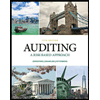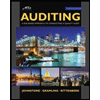
a)
Introduction:Audit risk is the risk thatthe auditor mightdeclare an unqualified report due to his failure in detecting a material misstatement either due to error or fraud.
To state:that the audit risk should be considered at zero level for almost all the audit assignments.
Introduction:Inherent risk is the risk generated by an error or omission in a financial statement because of a factor other than failure of internal control. In a financial audit, inherent risk is most likely to occur when transactions are complex,or when the situations need a high level of judgment for the financial estimates.
To state:That the Inherent risk factor as low as zero level impacts the auditor for not going into detailed examination of the books of account.
Introduction:Control risk is the probability that financial statements are significantly wrong,because of failures in the
To state:That the auditor has to collect evidences on design as well as operations of controls, to assess the control risk at low level.
Introduction:Detection risk is the risk that auditor will not be able detect a misstatement that is found in the decision that could be significant, either individually or collectively.
To state:that detection risk at 50% means that the auditor can rely to the extent 50% about the existence of any material misstatement.
Introduction:Audit risk is the risk that the auditor might declare an unqualified report due to his failure in detecting a material misstatement either due to error or fraud.
To state:That audit risk vary in relation to inherent risk and control risk and has inverse relationship.
Introduction:Audit risk model is a technique which is used by auditors to assess the relationship between various risks generating from an audit assignment, which enables the auditor to manage the overall audit risk.
To state:that judgment of the auditor is a key factor while deciding about the audit risk model.
Trending nowThis is a popular solution!

Chapter 7 Solutions
ACP AUDITING - RISK BASED APPROACH
- Explanation of this accounting questionarrow_forwardSolve this accounting problem please answer do fastarrow_forwardFranco Corp. purchased an item for inventory that cost $30 per unit and was priced to sell at $50. It was determined that the disposal cost is $28 per unit. Using the lower of cost or net realizable value (LCM) rule, what amount should be reported on the balance sheet for inventory? Helparrow_forward
- General Accounting Questionarrow_forwardDunley Motors purchased a delivery van on January 1, 2017, for $62,000. The van had an estimated life of 4 years and an estimated residual value of $18,000. Dunley's year-end is December 31st. Assuming Dunley uses the straight-line depreciation method and the company sold the van on July 1, 2019, for $30,000, determine the gain or loss on disposal. Helparrow_forwardGet accurate solution of this accounting questionarrow_forward
 Auditing: A Risk Based-Approach (MindTap Course L...AccountingISBN:9781337619455Author:Karla M Johnstone, Audrey A. Gramling, Larry E. RittenbergPublisher:Cengage Learning
Auditing: A Risk Based-Approach (MindTap Course L...AccountingISBN:9781337619455Author:Karla M Johnstone, Audrey A. Gramling, Larry E. RittenbergPublisher:Cengage Learning Auditing: A Risk Based-Approach to Conducting a Q...AccountingISBN:9781305080577Author:Karla M Johnstone, Audrey A. Gramling, Larry E. RittenbergPublisher:South-Western College Pub
Auditing: A Risk Based-Approach to Conducting a Q...AccountingISBN:9781305080577Author:Karla M Johnstone, Audrey A. Gramling, Larry E. RittenbergPublisher:South-Western College Pub


